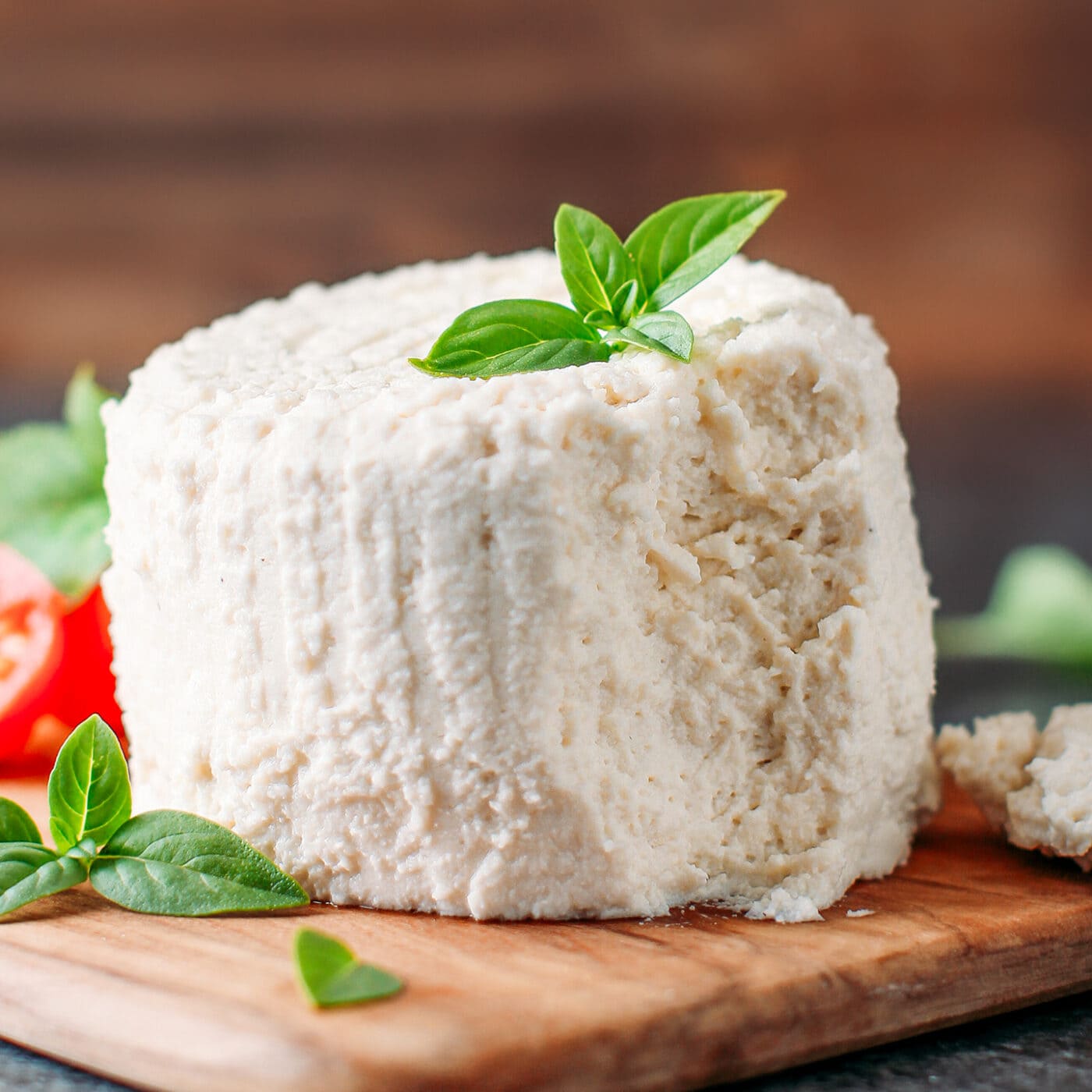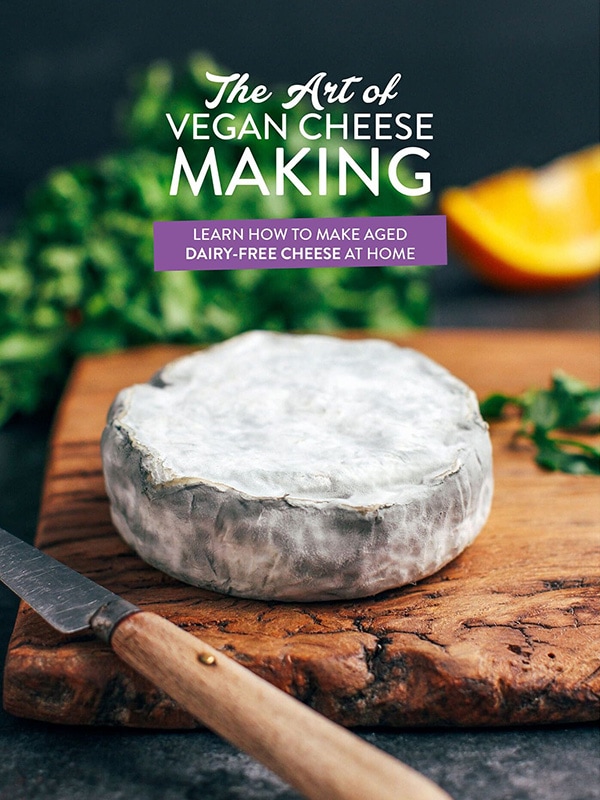This post may contain affiliate links. Please read our disclosure policy.
This vegan ricotta has the typical light and fluffy texture with a subtle tanginess. It tastes just like the Italian classic, minus the dairy! Crumble into pasta, use in pizza, or as a filling for cannelloni or shells! Soy-free and coconut-free!

This recipe is from my eBook “The Art of Vegan Cheese Making“. If you haven’t got it yet, you can download your free copy by signing up for the newsletter here. In this post, I’m going to go a bit deeper into the exact process of making this vegan ricotta.
⭐️ Why You Should Try This Recipe
- Light and fluffy. This ricotta has a rich and airy texture. It spreads great and has a texture extremely close to the real one!
- It doesn’t require lemon. As opposed to other vegan ricotta recipes that make use of lemon, lime, or vinegar to curdle the milk and add tanginess, this one relies on real cultures and a special enzyme to curdle the cashew milk. The result is a more natural and authentic flavor!
- It’s versatile. You can use this ricotta on toast, drizzled with some olive oil or maple syrup, or use it as a base for baked shells, pizza, and more!
📘 What is Ricotta
Ricotta is an Italian fresh cheese traditionally made using leftover whey from a batch of cultured cheese. Ricotta means “recooked” as the leftover whey is repurposed and cooked again with a coagulant like lemon juice or vinegar. There are many different ways to make ricotta. Some are prepared using the traditional method, while others will start with whole fresh milk.
This recipe is based on the type of ricotta that is cultured and aged (but made vegan!). It gives a cheese with a more pronounced flavor.

🥛 Ingredient Notes
This vegan ricotta recipe requires only 5 ingredients. Here is what you will need:
- Raw cashews – The base of this vegan ricotta is raw cashews. They bring richness and creaminess. I do not recommend using other nuts for this recipe.
- Miso – Optional. The addition of white miso helps create a more complex flavor.
- Probiotics – These will allow the cashew cream to ferment and get a natural tangy/sour flavor. You can use Acidophilus probiotics or mesophilic culture.
- Transglutaminase – The key ingredient to make this vegan ricotta fluffy, just like real ricotta. Don’t be scared by this strange name. Transglutaminase is an enzyme that binds the proteins and helps plant-based milk curdle. You can now find vegan transglutaminase online easily.
- Salt – To enhance the flavor.
🥣 How to Make Vegan Ricotta
This recipe consists of 3 steps: Preparing the cashew milk, curdling and culturing it, and finally, draining it.

Prepare the cashew milk
- Make the milk. Drain the cashews and place them in a blender. Add the water, sweet white miso, and salt. Blend on high speed, occasionally scraping down the sides until you get a smooth texture.
- Add the culture. Add the mesophilic or acidophilus culture and blend for another 10 seconds.
- Add the Transglutaminase. Dissolve the transglutaminase in 2 tbsp water. Add it to the blender and blend for another 10 seconds. The cashew milk is now ready for the next step!
Curdle the milk and culture it
- Activate the Transglutaminase. Pour the cashew milk into a large glass bowl and cover with plastic film. To activate the transglutaminase, you must keep the cashew milk at around 104°F (40°C) for 4 hours. To do that, you can use an Instant Pot, a yogurt maker, or an oven if it can go at that temperature.
- After 4 hours, remove the cashew milk bowl from the heat. It should no longer be liquid but a bit thicker.
- Culture. To give the ricotta a natural tanginess, let the cashew milk ferment at room temperature for another 6 hours or overnight.
If using an Instant Pot: Place one cup of water in the Instant Pot liner. Add the grid and place your bowl of cashew milk on top. Close the Instant Pot lid and set it on yogurt mode for 4 hours.


Drain the ricotta
- Prepare your draining station. After 6 hours of culturing, it’s time to drain the curdled cashew milk. Place a plastic or cookie grid on top of a baking sheet, large baking dish, or deep plate. There should be space between the grid and the bottom of the baking sheet to allow the whey to drain.
- Place two ricotta molds on top of the grid. Using a large spoon, fill the molds with the curdled cashew milk. Fill each basket to the top. Note: I used two 10oz (0,3 Kg) molds.
- Drain. Carefully transfer the baking sheet with the ricotta molds to the refrigerator and let it drain overnight or for at least 8 hours.
- The next day, your ricotta will have lost a lot of water. You can now carefully remove the ricottas from the molds and enjoy!


If you prefer firmer ricotta, use the little plastic rounds that come with ricotta baskets and place them on top of the mold. Then place a weight on it and let it drain for another 3 hours in the refrigerator.

Smoked Ricotta (Ricotta affumicata)
Did you know you can smoke ricotta? Called “Ricotta affumicata” in Italian, this type of ricotta is smoked over wood chips, giving it an intense flavor. Here is the process of smoking ricotta:
- Start by preparing your stovetop smoker. Add 1 tablespoon of wood chips to the bottom of the smoker. Place the drip and cooking trays on top of the wood chips.
- Fold a sheet of parchment paper 4-5 times to form a thick square of paper. Place the square of parchment paper on top of the smoking grid.
- Carefully place the ricotta on top of the parchment paper.
- Heat the smoker over low-medium heat on a stovetop burner. Once the smoke starts to appear, close the smoker’s lid completely and smoke the ricotta for about 12-15 minutes or until golden brown. Some smoke will escape from the smoker. That’s normal.
- Remove the smoker from the heat and let it cool for about 10 minutes with the lid on.
- Remove the lid and let the ricotta cool for another 20 minutes. Next, transfer the ricotta to a plate (ricotta is fragile, so be careful while handling it).
- Refrigerate for 2-3 days to allow the flavors to merge and the smoky flavor to fade slightly.
🍕 Where To Use It
The best thing about this vegan ricotta is that there are countless ways to use it! Here are a few ideas:
- Spread on crackers or bread: Spread on salty crackers or toasted bread, and top with caramelized onions, roasted tomatoes, and ground black pepper!
- Add to charcuterie boards: Drizzle with some olive oil or maple syrup if you prefer a sweet and salty version, and serve it on your vegan charcuterie board or antipasto platter.
- Use on pizza: Top your vegan pizza with crumbled ricotta! I personally love to use the smoked version to add a comforting and smoky flavor to homemade pizza.
- Add to pasta: Scramble vegan ricotta on top of pasta for freshness. It would be delicious with this Mushroom Pasta with Creamy Peppercorn Sauce, Easy Pasta Stir-Fry, or this Caramelized Onion Pasta.
- Use to prepare savory fillings: Combine with chopped fresh herbs and/or spinach and use it as a filling for cannelloni or stuffed shells.
- Use in desserts: This vegan ricotta is perfect for vegan cannolis. You can also spread it on top of French toast and drizzle with maple syrup or use it to make ricotta pancakes!

💬 FAQ
It helps bind the proteins and curdle the cashew milk. By using transglutaminase, there is no need to use a combination of soy milk and lemon juice/vinegar, giving this vegan ricotta a more authentic flavor.
Unfortunately, this recipe is not versatile, so I do not recommend substituting or omitting any ingredient.
While it doesn’t taste exactly the same, it’s very close. The texture is fluffy and creamy without feeling heavy.
You can keep this vegan ricotta in the refrigerator for up to 7 days.
🧀 More Vegan Cheese Recipes
If you are looking for more delicious vegan cheeses, I have got you covered with these top-rated recipes:
Let me know in the comments if you try this recipe!


Vegan Ricotta (Naturally Cultured!)
Equipment
Ingredients
- 1 and 1/2 cup raw cashews soaked overnight
- 3 cups water
- 2 tsp sweet white miso optional
- 1/4 and 1/8 tsp salt
- 2 capsules capsules acidophilus or 1/8 tsp mesophilic culture
- 2 tsp transglutaminase
Instructions
- Make the cashew milk. Drain the cashews and place them in a blender. Add the water, sweet white miso, and salt. Blend on high speed, occasionally scraping down the sides until you get a smooth texture.
- Add the culture. Add the mesophilic or acidophilus culture and blend for another 10 seconds. Next, dissolve the transglutaminase in 2 tablespoons of water. Add it to the blender and blend for another 10 seconds. The cashew milk is now ready for the next step!
- Curdle the milk. Pour the cashew milk into a large glass bowl and cover with plastic film. To activate the transglutaminase, you must keep the cashew milk at around 104°F (40°C) for 4 hours. To do that, you can use an Instant Pot, a yogurt maker, or an oven if it can go at that temperature.After 4 hours, remove the cashew milk bowl from the heat. It should no longer be liquid but a bit thicker.
- Culture. Next, let the cashew milk ferment at room temperature for another 6 hours or overnight.
- Drain the ricotta. Place a plastic or cookie grid on top of a baking sheet, large baking dish, or deep plate. There should be space between the grid and the bottom of the baking sheet to allow the whey to drain. Place two ricotta molds on top of the grid. Using a large spoon, fill the molds with the curdled cashew milk. Fill each basket to the top. Note: I used two 10oz (0,3 Kg) ricotta molds.
- Carefully transfer the baking sheet with the ricotta molds to the refrigerator and let it drain overnight or for at least 8 hours.
- The next day, your ricotta will have lost a lot of water. You can now carefully remove the ricottas from the molds and enjoy!
Notes

About the Author
Thomas Pagot is the founder, photographer, and recipe developer behind Full of Plants. He created the blog in 2016 as a personal cookbook for vegan recipes. Through years of recipe development, Thomas has successfully grown Full of Plants into a trusted resource for plant-based recipes.

🧀 25 Mind-Blowing Vegan Cheese Recipes!
Sign up for the Full of Plants newsletter and you’ll get new recipes delivered by email weekly, PLUS your FREE 100-page printable eBook!


Hi, what will be the consistency if transglutaminase is not used in this recipe?
Hi Agnese,
It will just be cultured cashew milk. Nothing else will happen if you omit the transglutaminase.
Hi Thomas, I see the transglutaminase is not available and they say they don’t know when it will be available again, is there an alternative to it ? Christine.
Hi Christine,
Unfortunately, there is no alternative. Maybe try doing a quick Google search, you should be able to find websites that carry vegan brands.
Wondering about the use of transglutaminase with the health concerns outlined at this link and if the recipe can do without it?
Hi Fiona,
Unfortunately, there is no substitute, it’s the only ingredient that can curdle cashew milk that way.
Hi there
I made this but my cashew “yogurt” is still watery. I am at the step to transfer the cheese to the mold and let it drain but is is much too watery.
What’s the deal? Should I let it sit in the yogurt maker longer? Should I let it sit out longer?
Help!
Hi Stephanie,
Did you use Transglutaminase? Also, it’s normal that it is still a bit watery but it should have thickened (as you can see on the photos). Maybe try to active the TG for another 2-3 hours.
Same issue for me. After curdling/culturing, I mixed the cashew milk and tried spooning it into the ricotta molds. Nearly all of it just drained out from the bottom of the molds. Was I only supposed to skim the top/solid parts of the curdled cashew milk rather than mixing it?
You used transglutaminase right? Also, did you activate the transglutaminase as noted in the recipe?
Look amazing. I’ll try it this weekend.
Thanks Emy! Let me know how it goes!
Hi Thomas!
I just looked at this product on Amazon and Mesophilic Culture has rennet in it. That means it’s not vegan right? This is an animal product as far as I can see. Thoughts?
Hi Deb!
Well, mesophilic culture doesn’t contain rennet. I guess you are talking about the two tablets they add to the package, then yes, that is not vegan but the mesophilic culture is.
You can probably find another brand that only contains mesophilic culture in the package, or simply use acidophilus probiotics 😉
Wow, don’t think I will make this cheese! The transglutaminase is not something I am likely to consume, as I have gluten intolerance. Can it be made without a binding agent?
Hi,
Unfortunately, as noted in the notes and the post, Transglutaminase cannot be substituted or omitted in this recipe. If you don’t want to use it, I would recommend trying to find a different vegan ricotta recipe that may use soy milk and lemon juice to curdle it.
Please note: I removed your rating, as you gave it 1 star without trying the recipe. It takes a lot of trials and time to develop recipes, so please only rate them after actually giving it a try 😉
Can I use sundlower seeds, pumpkin seeds? To make the ricotta instead of cashews
I haven’t tried so I can’t say for sure, but it would definitely alter the flavor.
Thank you.
I’m a big fan of your recipes and so is my family. My son and wife come over every alternate weekend and can’t wait to see what we’re having for lunch. For a person who doesn’t like to cook, I’m now ordering speciality ingredients from Amazon and Asia Mart. Ha.
Just wondering if you’ve tried using the transglutimase in other recipes, eg. soy yoghurt, as it’s quite expensive here? (Italy)
Thank you for your time and sharing your creativity.
Hi Jaslyn,
Thanks for your feedback, I really appreciate it!
Regarding the transglutaminase, I haven’t used it in other recipes yet (except the blue camembert in the ebook).
I love this recipe! It’s delicious. Can I freeze it to use later?
I haven’t tried freezing yet, so I’m afraid I cannot say for sure.